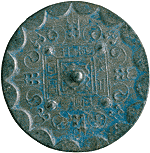|
 Happiness and Harmony: Happiness and Harmony:
The Never-ending Cycle of Life
(Chinese views
on life and death)
Many representative Chinese cultural objects are circular in shape.
Some prominent examples are Bi (a round jade piece with a hole in
it), ring, and Chue (a jade ring). Circle alleges to Heaven, and
is a symbol to express the Chinese' cosmic conception. Viewing Heaven
to be round, the Chinese accepted the notion that life is eternal
and circular.
 Heaven
and Earth Heaven
and Earth
Based on the movement pattern of the Sun, the Chinese perceived
that Heaven is round. The cycle of seasons, seasonality of plants
and flowers, as well as tidal cycle, all of which confirmed the
circular nature of time and the universe. Derived from these observations,
the Chinese formed a conception of life, that is, life is eternal
as in a circular movement.
Time
and Temporality
Early in the Chinese civilization, the Chinese created a farming
calendar, or the lunar calendar, based on their observations of
the seasonal cycle. They plough in spring and harvest in autumn.
The coordination of farming activities and the seasonal cycle reflected
the intimate dependence of the Chinese on nature.
 Human
Life Human
Life
For the Chinese, the meaning of life is expressed by a circle. The
form of a circle represents a completion and harmony. In view of
this, a life begins with birth, growth, illness, and death, and
thus forms a small circle. On a larger scale, the circle of life
contains numerous lives, some in the beginning, some in the mid-age,
and some in the end. Because of this view, short-term happiness
or a matter of short failing only plays a small role when the completed
and harmonious ending is anticipated.
Other
Titles
|

 Happiness and Harmony:
Happiness and Harmony:
 Heaven
and Earth
Heaven
and Earth
 Human
Life
Human
Life